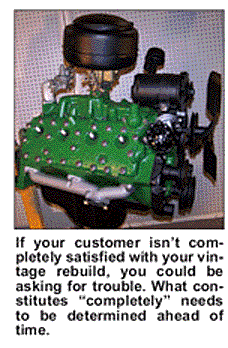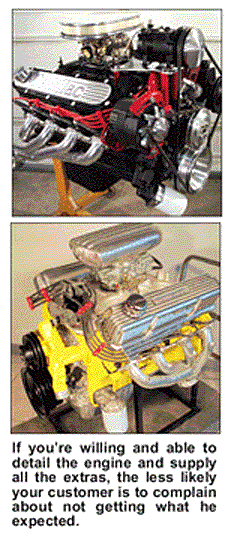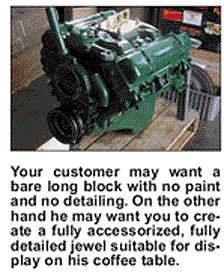Here’s the scene: You’ve just completed the machine work and assembly of a fine vintage engine. It may be for a restoration or a hot rod or a custom. You may have rattle-canned the block and heads and maybe wrapped it up in a baggie.
To you, knowing that function is primary, the job is done and your customer SHOULD be elated. They’ll name their kids after you. Not so fast, Bunkie, that job is not done unless you are looking for trouble.

One main problem comes with incomplete engines. You and I appreciate the value of good machine work and careful assembly and can sense the quality inside. Your customers often don’t know squat about this and only care about engine mythology and the impact of appearance. They also care about having to find or rebuild the rest of the engine components once they have a long block – a job they often have trouble getting done. There are ways to make your customers more happy and ways to prevent disappointment from setting in and among them:
If your customer only wants the long block, make sure that’s clear up front. Often these customers will not understand that all the accessories are extras and not part of a normal rebuild. Communication is critical. It also shows your interest and the customer will appreciate that.
Offer to supply these parts. Of course, you’ll need to know the sources, but that information can make you money. For example, if you know that Egge Machine has rebuilt water pumps and fuel pumps, you can sell them to your customer. If you don’t, he’ll have to start looking and that can be frustrating and a reason to complain. If you know that Totally Stainless has a complete stainless fastener kit for his engine, you can sell the kit and make him happy. Again knowledge is money.
Be willing and able to detail the engine. This requires better cleaning of the parts and some basic knowledge of painting. It takes some understanding of how to make parts look good. It takes patience (something often short in your customer’s repertoire). It takes time that you get paid for.

This includes setting up the distributor and wiring. It means running wiring in an attractive way – neat and tight and professional instead of a rat’s nest. It means finding or building the carburetor and running plumbing. It means installing the fuel pump, water pump, manifolds (and coatings for them), accessory drive parts, or any other components to complete the engine without excuses – all that you agree to do in advance and for a fee.
When you discuss these options, have a good idea of the costs so you can make them clear to the customer. Don’t make it sound like a negotiation or that you are unsure. You may want a price list available. You may want to package items. If the customer wants them you make money; if he declines, you’ve offered and he’s refused and he has no complaint later. Each choice has a consequence, so document them.
Don’t look at vintage engines like taxi cab rebuilds. These are special engines that require more time and money to build so don’t try to do it for the same price as a wham-bam small block Chevy. If your customer doesn’t understand this, send him down the road – there’s no win here. Price them according to the value and the costs and not to low-ball your way into a job.
The bottom line is to increase customer satisfaction by making the work to be done clear, offering him the options he may not realize are available, and providing what he really wants. The more you engage the customer with a sense that he is involved and in charge, the less he can find to complain about or feel shorted with later. The more involved he is in making these decisions, the more likely you will be to provide all he wants and envisions. I find that the better job you do up front the better the transaction ends up.
Another problem here is that this kind of customer is not only buying the function of that new engine but the appearance. It only makes sense that people who do 90 percent of their work making something LOOK good enough to win awards or gather crowds will expect the same from you. If they don’t see their dream when they come to pick up their engine, it’s the start of dissatisfaction and an opening for arguments and bad-mouthing. Here’s a few things you can do to keep that warm and fuzzy feeling between you and your customer:
Talk to them up front about appearance. Find out what they want in terms of finish and color and paint type or if they want to do it themselves. Let them know that you share their interest in appearance and you’ll become an ally rather than an adversary. If they want you to do it, settle on a price.
Find out if they want the block detailed. This is typically using a die grinder and flat grinder to remove and smooth out the casting flash and flaws, but can be more extensive up to and including smoothing the entire block and heads. It takes time and that means more profit, but it has to be done well before assembly.
Determine whether they want specific eye-candy such as stainless steel hardware, special accessory parts or finishes (from paint to chrome to high-tech coatings) and sell these things as options.
Ask about speed parts and dress parts. Your customer may already have them but often you can light up a job by knowing where to find them and selling them as options. This not only adds to profit, but these are the kind of things that a customer latches onto as part of the dream he is buying from you.
Be flexible. Your customer may want a bare long block with no paint and no detailing. On the other hand he may want you to create a fully accessorized, fully detailed jewel suitable for display on his coffee table. If you are both able and willing to supply what he wants, you will have a happy customer.

In the same light, avoid trying to steer a customer away from his dream. If you hate the color he’s chosen, or think the valve covers are gaudy, or don’t think his choice in carburetion is right, you need to keep it zipped. Your only concern in terms of components and machine work should be from the functional view. If you have reservations, voice them but remember who’s paying. If you are concerned about function, tell him and then document the decision. Appearance is personal choice and you will only irritate or alienate your customer if you try too hard to change his view. When you build your own it’s your chance to show your taste and massage your ego, but for your customer it’s your job to do good work, make his day, provide all the services he needs, and smile while he counts out large bills for your services.













